Role of Self Concept
What’s the Role of Self-Concept in School Climate and Career Readiness?
The role of self-concept is often overlooked or ignored as positive school climate and career readiness programs are developed. Learn about the essential missing link of self-concept in this workshop. The self-concept series and weave process is explained in detail with implications and implementation for your school counseling community. You can count on us to help you put everything in this PPT in place within your school counseling program!
Role of Self Concept
AOCC 2015 Conference Hilton Columbus at Easton Town Center November 5, 2015
If you have additional questions:
Dr. Tommie Radd, Counselor, Columbus City Schools, Columbus, OH, can be reached at her home office: Phone: 614-795-1373 Email: [email protected] or [email protected]. Web site: www.allsucceed.com
Dr. Doris Coy, Consultant, can be reached via email at: Email: [email protected]
The self-concept a person develops becomes the guiding light to show him and others the way he sees himseif. All people need to understand that they are worth working for, growing for, and developing their spirit, purpose and potential for. – Tommie R. Radd, PhD
What’s the Role of Self-Concept in School Climate and Career Readiness?
Agenda
- Introduction
- The Overview of ASCA Standards, NCDA Crosswalk, and School Counseling Program
- An Overview of the Guidance System and System Components
- The Heart of the Real Classroom, Life Lab, and Career Readiness Discussed
- The Role of Self-Concept and the Self-Concept Energizer
- The Self-Concept Series and Weave
- Ways of using the SCS in the Guidance System and School Counseling Program
- The Impact of the Self-Concept Process on Climate and Career Readiness
- Participant Brainstorm for Implementation of SCS.
- Questions & Closing

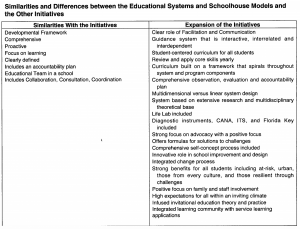
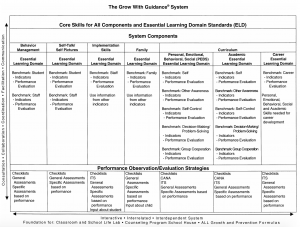
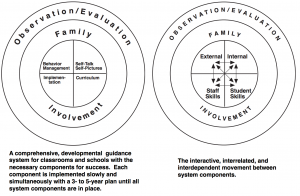
Overview of a Guidance System
- Behavior Management – Extrinsic – what we say and do
- Self-Talk & Self-Pictures – Intrinsic – what we say and believe with what we think and feel
- Curriculum – Student Skills • Implementation – Staff Skills •
- Family Involvement – Family Skills
- Observation/Evaluation
System Components Implemented
- Congruent
- Systemic – identify all components of the System or whole and understand the relationship between components
- Slowly and simultaneously
- 3-5 year process
- The Whole is larger than the sum of the parts
The whole is equal to more than the sum of its parts. —Tommie R. Radd, Ph.D.
Classroom Group Guidance System Checklist
-
- Positive Behavior Plan
- Share Benchmarks, Standards, and Indicators
- Self Concept Series/Weave as it relates to Behavior
- Five Star Class Meetings
- Class Responsibilities and Guidelines
- Problem Solving – “Help” vs “Hurt”
- Effective Behavior Interactions
- Problem Ownership
- Cooperative Strategies
- Contracts
- Peer Group Work
- The Five C’s for Maintaining Conflict
- Performance Observation/Evaluation
- Increase Component Implementation Annually
- Self-Talk/Self-Pictures Plan
- Share Benchmarks, Standards, and Indicators
- Self Concept Series/Weave as it relates to Self-Talk/Self-Pictures
- Activity Process General Self-Talk
- Activity Process Specific Self-Talk
- Activity Process General Self-Pictures
- Activity Process Specific Self-Pictures
- Incorporate Relaxation
- Performance Observation/Evaluation
- Increase Component Implementation Annually
- Curriculum Plan
- Share Benchmarks, Standards, and Indicators
- Self Concept Series/Weave as it relates to Student Skills
- Begin Core Activities
- CANA (Children’s Affect Needs Assessment) Administered
- ITS (Invitational Teaching Survey) Administered
- Florida Key Administered
- CANA Pre Report
- ITS Pre Report
- Florida Key Pre Report
- Selective Activities
- Format Implemented for all Activities
- Performance Observation/Evaluation
- Post CANA, Post ITS, and Post Florida Key Tests Administered
- CANA, ITS, and Florida Key Post Reports
- Report summary written including all year-end performance Observation/Evaluation information
- Increase Component Implementation Annually
- Staff Improvement Skills
- Share Benchmarks, Standards, and Indicators
- Self Concept Series/Weave as it relates to Staff
- Overview of the System
- Overview of Behavior Management Component
- Overview of Self-Talk/Self-Pictures Component
- Overview of Staff Implementation Skills
- Overview of Curriculum Component
- Conduct Staff Needs Assessment
- Prioritize Staff Skills
- Encouragement Strategies
- Prioritize Group Techniques
- Prioritize Other Needs Based on the ITS and Needs Assessment
- Performance Observation/Evaluation
- Increase Component Implementation Annually
- Family Involvement
- Share Benchmarks, Standards, and Indicators
- Self Concept Series/Weave as it relates to Family
- Overview of the System
- Overview of Behavior Management Component
- Overview of Self-Talk/Self-Pictures Component
- Overview of Staff Implementation Skills
- Overview of Student Curriculum Component
- Conduct Family Needs Assessment
- Prioritize Skills from Behavior Management Component
- Prioritize Skills from Self-Talk/Self-Pictures Management Component
- Prioritize Skills from Staff Implementation Skills
- Prioritize Skills from Curricular Core and Other Skills
- Performance Observation/Evaluation
- Increase Component Implementation Annually
- Positive Behavior Plan
It is recommended that all system information be included for families when possible.
- Developed a 3-to-5 year plan in the components for simultaneous, slow implementation
- Behavior Management
- Self-Talk/Self-Pictures
- Curriculum
- Implementation Skills
- Family Involvement
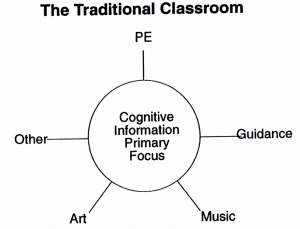

Life Lab
A way of defining the classroom as a simulation in which students, pre-K-12 and beyond, learn, experience, and apply the essential skills needed for life; the comprehensive developmental guidance system creates a life lab in every classroom through which students develop a conscious and intentional frame of reference that can be applied throughout life.

Suggested Elementary Counselor Time Allocations
- Foundation: 40%
- Counseling Groups: 30%
- Individual Counseling: 10%
- All Others: 20%
Suggested Middle/JR. High School Counselor Time Allocations
- Foundation: 35-30%
- Counseling Groups: 30-35%
- Individual Counseling: 10%
- All Others: 25%
Suggested High School Counselor Time Allocations
- Foundation: 30-25%
- Counseling Groups: 30-35%
- Individual Counseling: 10%
- All Others: 25-35%
Self-Concept Series Energizer
- Hi. My name is _______________.
- I am valuable because there is no one else like me in the world.
- One thing about me is ________________________.
Self-Concept Series
- All are special and valuable no matter what they think, say, do, or feel. TRUTH
- All show they are remembering that all are valuable by making helpful vs. hurtful choices toward self and others. BEHAVIOR
- I am responsible. ACCOUNTABILITY
Also included in Counseling Children, 11th Edition by Henderson and Thompson, Chapter 6
Weave
- Use of Language – help & hurt in place of: good, bad, should, right, wrong, ought, must
- Relate to behaviors as you see them
- Reframe language into helpful and hurtful
- Integrate into music
Inviting Yourself With Self Talk and Self Pictures
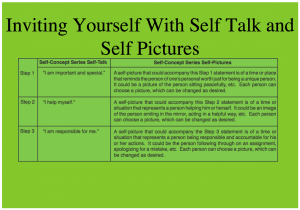
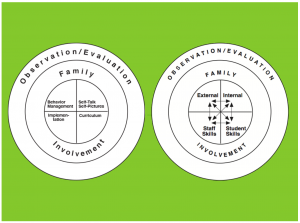
Get Started – Start Now
- List 3 ways you can begin the SCS-Weave in your program and school.
- Explain ways that addition supports an inviting climate and career readiness.
References
Radd, T. R. (2014). Teaching and Counseling for Today’s World: Pre-K-12 & Beyond Second Edition. Columbus, Ohio: Grow With Guidance. ISBN: 978-1-878317-58-2
Radd, T. R. (2014). Teaching and Counseling for Today’s World: Pre-K-12 & Beyond Second Edition, e-book. Columbus, Ohio: Grow With Guidance. ISBN: 978-1-878317-61-2
Radd, T. R. (2007). The Grow With Guidance System Manual Third Edition. Omaha, Nebraska: Grow With Guidance. ISBN: 978-1-878317-53-7 (1-878317-53-9).
Radd, T. R. (2014). The Grow With Guidance System Manual Third Edition, e-book. Columbus, Ohio: Grow With Guidance. ISBN: 978-1-878317-59-9
Radd, T. R. (2007). The Grow With Guidance Primary Level Third Edition. Omaha, Nebraska: Grow With Guidance. ISBN: 978-1-878317-54-4 (1-878317-54-7).
Radd, T. R. (2014). The Grow With Guidance Primary Level Third Edition, e-book. Columbus, Ohio: Grow With Guidance. ISBN: 978-1-878317-60-5
Radd, T. R. (2007). The Grow With Guidance Intermediate Level Third Edition. Omaha, Nebraska: Grow With Guidance. ISBN: 978-1-878317-55-1 (1-878317-55-5).
Radd, T. R. (2014). The Grow With Guidance System Intermediate Level Third Edition, e-book. Columbus, Ohio: Grow With Guidance. ISBN: 978-1-878317- 62-8
Radd, T. R. (2007). The Grow With Guidance Middle School Level Third Edition. Omaha, Nebraska: Grow With Guidance. ISBN: 978-1-878317-56-8 (1-878317-56-3).
Radd, T. R. (2014). The Grow With Guidance Middle School Level Third Edition, e-book. Columbus, Ohio: Grow With Guidance. ISBN: 978-1-878317-63-6
Radd, T. R. (2007). The Grow With Guidance High School Level Third Edition. Omaha, Nebraska: Grow With Guidance. ISBN: 978-1-878317-57-5 (1-878317-57-1)
Radd, T. R. (2014). The Grow With Guidance High School Level Third Edition, e-book. Columbus, Ohio: Grow With Guidance. ISBN: 978-1-878317-64-4 References (Continued)
Radd, T. R. (2006). Classroom Activites for Teachers, Counselors, and Other Helping Professionals Pre-K–12 & Beyond Vol. I. Omaha, Nebraska: Grow With Guidance. ISBN: 1-878317-45-8
Radd, T. R. (2014). Classroom Activities for Teachers, Counselors, and Other Helping Professionals: Pre-K-12 & Beyond Vol I. Second Edition, e-book. Columbus, Ohio: Grow With Guidance. ISBN: 1-878317-65-2
Radd, T. R. (2006). Classroom Activites for Teachers, Counselors, and Other Helping Professionals Pre-K–12 & Beyond Vol. II Omaha, Nebraska: Grow With Guidance. ISBN: 1-878317-46-6
Radd, T. R. (2014). Classroom Activities for Teachers, Counselors, and Other Helping Professionals: Pre-K-12 & Beyond Vol II Second Edition, e-book. Columbus, Ohio: Grow With Guidance. ISBN: 1-878317-65-
Radd, T. R. (2014). The Grow With Guidance System Music: G. G. Raddbearie Sings, e-book. Columbus, Ohio: Grow With Guidance. ISBN: 978-1-878317-68-7
Radd, T. R. (2007). The Grow With Guidance® System Music: G.G. Raddbearie Sings. Omaha, Nebraska: Grow With Guidance. isbn: 978-1-878317-47-6 (1-878317-47-4).
Radd, T. R. (2014). The Grow With Guidance System Fun Game Second Edition, e-book. Columbus, Ohio: Grow With Guidance. ISBN: 978-1-878317-67-9
Radd, T. R. (2007). The Grow With Guidance® System F.U.N. Game, Second Edition. Omaha, Nebraska: Grow With Guidance. ISBN: 978-1-878317-49-0 (1-878317-49-0)
Radd, T. R. (2006). The History, Development, and Research of the Educational Systems Model: The Grow With Guidance® System. Omaha, Nebraska: Grow With Guidance. isbn: 978-1-878317-52-0 (1-878317-52-0).
A complete Research Report is available here.